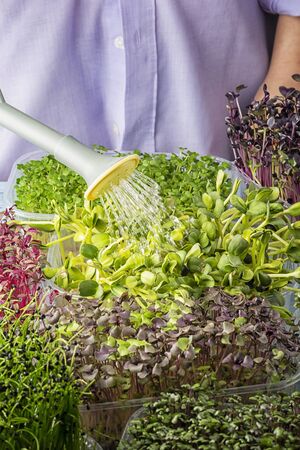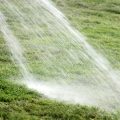1. What Is Hydroponics?
Hydroponics is a method of growing plants without using soil. Instead of planting directly in the ground, plants are grown in a nutrient-rich water solution that delivers everything they need to thrive. This modern gardening technique has become especially popular in the United States, where space-saving and efficient growing methods are more important than ever—especially for urban gardeners, hobbyists, and even commercial farmers.
How Does Hydroponics Work?
In traditional gardening, soil acts as a reservoir for nutrients and water. In hydroponics, those nutrients are delivered directly to the plant roots through water. This allows for more control over what your plants receive and often leads to faster growth and higher yields.
Main Components of a Hydroponic System
| Component | Description |
|---|---|
| Nutrient Solution | A mix of water and essential minerals that feeds the plants |
| Growing Medium | A soil substitute like rockwool, clay pellets, or coco coir that supports plant roots |
| Reservoir | The container that holds the nutrient solution |
| Pump & Delivery System | Carries the nutrient solution to the plant roots (in most systems) |
| Aeration System | Keeps oxygen flowing to the root zone, usually with air stones or pumps |
Why Is Hydroponics Gaining Popularity in the U.S.?
The rise of hydroponic gardening in America can be credited to several key advantages:
- Saves Space: Perfect for apartments, balconies, and small yards.
- No Soil Needed: Ideal for areas with poor or contaminated soil.
- Faster Growth: Plants often grow quicker due to direct access to nutrients.
- Sustainable: Uses up to 90% less water than traditional gardening.
- Pest Control: Fewer soil-borne pests mean fewer pesticides needed.
The Bottom Line on Hydroponics Basics
If youre looking for a clean, efficient, and high-yield way to grow your own herbs, vegetables, or even flowers, hydroponics might be exactly what you need. Whether youre starting a small indoor setup or dreaming of building your own vertical farm, understanding how hydroponics works is the first step toward success.
2. Essential Hydroponic Systems Explained
If youre just getting started with hydroponics, it can feel overwhelming trying to choose the right system. Luckily, many American hobbyists and small-scale growers use a few tried-and-true methods that are easy to set up and manage. Let’s break down the most popular hydroponic systems so you can find the one that fits your space, budget, and gardening goals.
Deep Water Culture (DWC)
This is one of the simplest and most beginner-friendly hydroponic systems out there. In DWC, plants sit in net pots suspended over a nutrient-rich water solution. An air pump supplies oxygen to the roots through an air stone placed in the water.
Pros:
- Easy to set up and maintain
- Low cost for basic setups
- Great for leafy greens like lettuce and spinach
Cons:
- Water temperature must be monitored
- Not ideal for larger plants
Ebb and Flow (Flood and Drain)
This system works by periodically flooding the grow tray with nutrient solution, then draining it back into a reservoir. A timer controls when the pump turns on and off, making sure your plants get nutrients and oxygen regularly.
Pros:
- Good for a wide variety of plants
- Encourages strong root growth
Cons:
- Slightly more complex than DWC
- Pump failure can harm plants if not caught quickly
Nutrient Film Technique (NFT)
NFT uses a sloped channel where a thin film of nutrient solution flows continuously over plant roots. The roots absorb nutrients while also getting plenty of oxygen from the air.
Pros:
- Efficient use of water and nutrients
- No growing medium required
Cons:
- Mainly suitable for small, fast-growing plants
- Pumps must run constantly—no backup means risk during power outages
Quick Comparison Table
| System Type | Main Features | Best For | User Level |
|---|---|---|---|
| DWC (Deep Water Culture) | Simplest design; roots suspended in oxygenated water | Lettuce, herbs, leafy greens | Beginner |
| Ebb and Flow | Pump floods and drains grow tray on timer | Larger plants, mixed crops | Intermediate |
| NFT (Nutrient Film Technique) | Nutrient solution flows constantly past plant roots | Lettuce, basil, other small fast-growers | Intermediate to Advanced |
No matter which system you choose, each offers its own benefits depending on what you want to grow and how much time you want to spend maintaining your setup. Starting simple with DWC is often a great way to dive into hydroponics without breaking the bank or getting overwhelmed.
![]()
3. Choosing the Right Plants for Hydroponics
One of the biggest advantages of hydroponic gardening is that you can grow a wide variety of plants without needing soil. However, not all plants are equally suited for this method—especially if youre just starting out. To make things easier, its best to begin with crops and herbs that are known to thrive in hydroponic systems and are commonly grown across the U.S.
Top Beginner-Friendly Plants for Hydroponics
When choosing your first plants, look for fast-growing, compact varieties that don’t need extensive support or complicated nutrient needs. Below is a list of popular and beginner-friendly options:
| Plant | Why It’s Great for Hydroponics | Tips for Beginners |
|---|---|---|
| Lettuce (Romaine, Butterhead) | Fast growth, shallow roots, low maintenance | Keep water temperature cool and provide consistent light |
| Spinach | Grows quickly and adapts well to most systems | Best in cooler temps; harvest outer leaves regularly |
| Basil | Aromatic herb that thrives in nutrient-rich water | Prune often to encourage bushier growth |
| Kale | Tolerant of varying conditions, rich in nutrients | Give it plenty of light and space to grow upward |
| Mint | Hardy herb that grows aggressively in water | Grow separately—it can crowd out other plants easily |
| Tomatoes (Cherry or Grape) | Fruit-bearing crop well-suited to hydroponics with proper support | Needs trellising and good airflow; choose dwarf varieties if possible |
Factors to Consider When Selecting Plants
Climate Compatibility
If youre growing indoors, you can control temperature and humidity. But if youre setting up your system outdoors or in a greenhouse, choose plants that match your regional climate.
System Type
Certain plants perform better in specific hydroponic systems. For example:
- Nutrient Film Technique (NFT): Best for leafy greens like lettuce and herbs.
- Deep Water Culture (DWC): Ideal for fast-growing crops like spinach and basil.
- Ebb and Flow: Works well with larger fruiting plants like tomatoes and peppers.
Growth Time and Space Needs
If you’re short on space or want quicker results, stick to compact varieties that mature quickly. Lettuce and herbs usually go from seed to harvest in just a few weeks.
A Quick Guide: Fast vs. Slow Growers
| Fast-Growing Plants (2–4 weeks) | Slower-Growing Plants (6+ weeks) |
|---|---|
| Lettuce Basil Spinach Cilantro |
Kale Dill Tomatoes Peppers |
Selecting the right plants is one of the first steps toward a successful hydroponic garden. Starting with easy-to-grow crops will give you the confidence and experience needed to expand into more complex varieties later on.
4. Must-Have Equipment and Supplies
Before you can start growing plants hydroponically at home, youll need to gather the essential tools and materials. Think of it like setting up a kitchen before cooking—you’ll need the right gear to get the job done. Heres a breakdown of what youll need to launch your own hydroponic garden, with a focus on products commonly available in the U.S.
Grow Lights
Since many indoor hydroponic systems don’t have access to natural sunlight, grow lights are crucial. In the U.S., LED grow lights are a popular choice because they’re energy-efficient and provide a full light spectrum that mimics sunlight. If youre just starting out, look for full-spectrum LED panels that are easy to mount above your growing area.
Hydroponic System Type
There are several types of hydroponic systems available. For beginners, Deep Water Culture (DWC) and Nutrient Film Technique (NFT) are user-friendly options. Many starter kits available online or at stores like Home Depot or Lowe’s come with everything pre-assembled.
Nutrient Solution
Since theres no soil, plants get their nutrients from a water-based solution. Look for liquid hydroponic nutrients labeled specifically for vegetables or leafy greens if youre planning to grow lettuce, kale, or herbs. Most U.S.-based brands like General Hydroponics offer easy-to-use 3-part nutrient systems that work well for beginners.
Water and pH Testing Tools
Maintaining the right pH level (typically between 5.5 and 6.5) is key to healthy plant growth. A digital pH meter and EC (electrical conductivity) meter will help you monitor nutrient levels accurately.
Basic Hydroponic Tool Checklist
| Item | Description | Recommended For Beginners? |
|---|---|---|
| LED Grow Lights | Full-spectrum lighting that supports plant growth indoors | Yes ✅ |
| DWC/NFT System Kit | Pre-made systems designed for easy setup and maintenance | Yes ✅ |
| Nutrient Solution | Liquid fertilizers made for hydroponic gardening | Yes ✅ |
| pH & EC Meters | Digital meters to measure acidity and nutrient strength in water | Yes ✅ |
| Airstone & Air Pump | Keeps water oxygenated in systems like DWC | Yes ✅ |
| Net Pots & Growing Medium | Support plants in place of soil; common media include clay pebbles or rockwool | Yes ✅ |
Growing Mediums
You’ll also need something to support your plants since there’s no soil involved. Popular options include clay pellets (also known as LECA), coconut coir, and rockwool cubes. These materials help anchor the roots while allowing water and air to flow freely.
Airstone and Air Pump
If youre using a system like Deep Water Culture, an airstone connected to an air pump will keep the water oxygen-rich—crucial for healthy root development.
Pro Tip:
You can find most of these supplies online through retailers like Amazon, or in-store at garden centers across the U.S., including big chains like Lowe’s or Walmart Garden Center.
This gear forms the foundation of any successful hydroponic setup. Once youve got your equipment ready, youll be one step closer to growing fresh herbs, veggies, or even fruits—all without touching a speck of soil!
5. Setting Up Your First Hydroponic System
Starting your hydroponic journey at home can feel a little intimidating, but with the right steps, its totally doable—even if you’ve never grown a plant before. This section will walk you through setting up a simple hydroponic system, maintaining water quality, and avoiding common beginner mistakes that many new growers in the U.S. make.
Step-by-Step Guide to Building Your First System
Step 1: Choose the Right Hydroponic System
For beginners, the best systems to start with are:
| System Type | Description | Best For |
|---|---|---|
| Deep Water Culture (DWC) | Plants sit in net pots suspended over nutrient-rich water with air stones providing oxygen. | Lettuce, spinach, herbs |
| Nutrient Film Technique (NFT) | A thin film of nutrients flows over plant roots in sloped channels. | Lettuce, small leafy greens |
| Kratky Method | A passive system where plants grow in still water without pumps or electricity. | Small-scale indoor use, leafy greens |
Step 2: Gather Your Materials
You’ll need:
- A container or reservoir (5-gallon bucket works great)
- Net pots and growing medium (like clay pebbles or rockwool)
- An air pump and air stone (for oxygenation)
- Hydroponic nutrients (formulated for veggies or herbs)
- A pH test kit or digital meter
- Grow lights (if youre growing indoors without natural light)
Step 3: Assemble the System
- Drill holes in the lid of your container to fit net pots.
- Fill the container with clean water and mix in your hydroponic nutrients according to label instructions.
- Add the air stone to the bottom of the reservoir and connect it to the air pump.
- Place your seedlings into the growing medium inside the net pots.
- Set the net pots into the lid so roots touch the nutrient solution.
- If indoors, position your grow lights about 6–12 inches above plants.
Maintaining Water Quality
Your plants depend entirely on the water they’re living in—so keeping it balanced is key. Heres what to monitor regularly:
| Factor | Target Range | Why It Matters |
|---|---|---|
| pH Level | 5.5 – 6.5 | Keeps nutrients available for plant uptake. |
| Nutrient Strength (EC/TDS) | Varies by plant stage (e.g., 800–1200 ppm for leafy greens) |
Avoids underfeeding or burning plants with excess nutrients. |
| Water Temperature | 65°F – 75°F (18°C – 24°C) | Prevents root rot and promotes oxygen absorption. |
| Dissolved Oxygen | Adequate bubbling from air stone | Keeps roots healthy and prevents diseases. |
Common Rookie Mistakes to Avoid
- Skipping pH checks: Even if your plants look fine now, an unbalanced pH can cause problems fast. Check at least every other day.
- Overfeeding nutrients: More isnt better. Start light and follow product guidelines based on plant type and growth stage.
- No backup power for indoor systems: A power outage can cut off your air pumps and grow lights. Consider a small battery backup for peace of mind.
- Poor lighting setup: If using LED grow lights, make sure they are full-spectrum and placed at proper distances to avoid leggy or burnt plants.
- Inefficient airflow: Indoors? Use a small fan to keep air circulating and prevent mold or mildew around plants.
You don’t have to be an expert to build a working hydroponic system at home. With some basic equipment and attention to detail, you’ll be enjoying fresh homegrown produce in no time!
6. Troubleshooting and Tips for Success
Even with the best setup, hydroponic gardening can come with a few bumps along the way—especially for beginners. Here are some common issues you might run into and practical ways to keep your indoor garden thriving in typical American home environments.
Managing pH Levels
pH plays a huge role in nutrient absorption. Most plants do well with a pH between 5.5 and 6.5. If your levels are off, your plants might not be getting the nutrients they need—even if youre adding them properly.
How to Check and Adjust pH:
- Use a digital pH meter or test strips for accurate readings.
- If pH is too high (alkaline), add a pH down solution—usually phosphoric acid-based.
- If pH is too low (acidic), add a pH up solution—often potassium hydroxide or similar base.
- Check and adjust daily, especially in small systems where fluctuations happen quickly.
Preventing Plant Diseases
Disease prevention starts with cleanliness. Indoor setups in American homes often lack natural airflow, which can lead to mold and mildew if you’re not careful.
Tips to Keep Plants Healthy:
- Air Circulation: Use small fans to mimic outdoor wind and reduce humidity buildup.
- Sterilization: Clean tools, containers, and reservoirs regularly with diluted hydrogen peroxide or vinegar solution.
- Water Temperature: Keep nutrient solution around 65–75°F (18–24°C). Warmer water can encourage bacterial growth.
- Avoid Overcrowding: Give each plant enough space for airflow around leaves.
Optimizing Yields
Your yield depends on several factors including light, nutrients, water quality, and temperature. Heres a quick breakdown of optimal ranges for indoor hydroponics in U.S. households:
| Factor | Optimal Range | Tips |
|---|---|---|
| Light | 12–16 hours/day | Use full-spectrum LED grow lights; keep them 12–24 inches above plants |
| Nutrients | Follow product-specific feeding schedules | Avoid overfeeding; more isn’t always better |
| Water Temp | 65–75°F (18–24°C) | Aquarium heaters or chillers can help maintain range year-round |
| Humidity | 40–60% | Use a dehumidifier or humidifier as needed based on season/location |
| Airflow | Mild constant circulation | Add oscillating fans to prevent stagnant air zones and pests |
Pest Control Indoors
You might think being indoors keeps pests away—but fungus gnats, spider mites, and aphids can still show up. Heres what you can do:
- Sticky traps: Great for catching adult gnats or flying insects.
- Nematodes or neem oil: Safe organic options for root zone pest control.
- Avoid overwatering: Especially in media like coco coir or rockwool that hold moisture.
- Quarantine new plants: Always inspect before introducing anything new to your system.
A Few Extra Tips for Beginners
- Start small: A simple deep water culture (DWC) bucket system is great for learning the basics without getting overwhelmed.
- Keep a journal: Track what works and what doesn’t—note changes in plant health after adjusting lights, nutrients, or other variables.
- Don’t panic over mistakes: Even experienced growers deal with setbacks. Hydroponics is all about learning and adapting!
A little attention goes a long way when growing hydroponically at home. With these troubleshooting tips under your belt, you’ll be better prepared to grow healthy plants year-round—no soil required!


